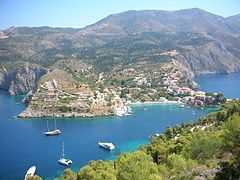Asos (Kefalonia)
|
Local community Asos Τοπική Κοινότητα Άσου (Άσος) |
||
|---|---|---|
|
|
||
| Basic data | ||
| Country |
|
|
| region | Ionian islands | |
| Regional district | Kafalonia | |
| local community | Kefalonia | |
| Parish | Erisos | |
| Geographic coordinates | 38 ° 23 ' N , 20 ° 32' E | |
| Height above d. M. |
20 m (average) |
|
| surface | 5.325 km² | |
| Residents | 88 (2011) | |
| Population density | 16.53 km² | |
| Local division | 1 settlement | |
Asos ( Greek Άσος ( f. Sg. ), Also Assos Άσσος) is a village with the status of a local community in the municipality of Erisos on the Greek island and municipality of Kefalonia on the edge of the Erisos peninsula, on which the Assos castle is located. It is located on a natural harbor, one half of which is used as a bathing beach , while smaller fishing boats moor on the other half.
The place as well as almost the whole island was destroyed by the earthquake of 1953 . The city of Paris financed the reconstruction of the destroyed houses so that no change in the appearance of the town is visible. Today a monument commemorates this. The few half-ruined houses are more a consequence of the depopulation that followed the earthquake.
The limited geographical capacities and the old building fabric have mostly limited the tourist use to travelers who take a break on the way to Myrtos Beach or Fiskardo .
Assos Castle
In ancient times, the area of the later castle was a separate island called "Asteris". The settlement of Nesiolae lay on top of it, the island near the coast gradually became part of Kefalonia through silting, and has since been connected by an isthmus .
Assos Castle was built in 1585 as a refuge for the local residents. In 1593 the Venetians decided to expand the castle into a larger citadel due to its strategic location . But since the most important problem, the water supply, could not be adequately solved, the citadel was never completed. Instead, the castle became the administrative seat of the Venetians, from which the north of the island was administered.
After the island of Lefkada was recaptured by the Venetians in 1684 , the castle lost its supraregional strategic importance, but was still used by the Venetians and the following powers as an administrative building, which is why the castle is now in a relatively complete structural condition. The two meter thick walls are noteworthy.
Individual evidence
- ↑ Results of the 2011 census at the National Statistical Service of Greece (ΕΛ.ΣΤΑΤ) ( Memento from June 27, 2015 in the Internet Archive ) (Excel document, 2.6 MB)
- ↑ Friedrich Carl L. Sickler: Handbook of old geography for high schools and for self-teaching p. 235. 1832



